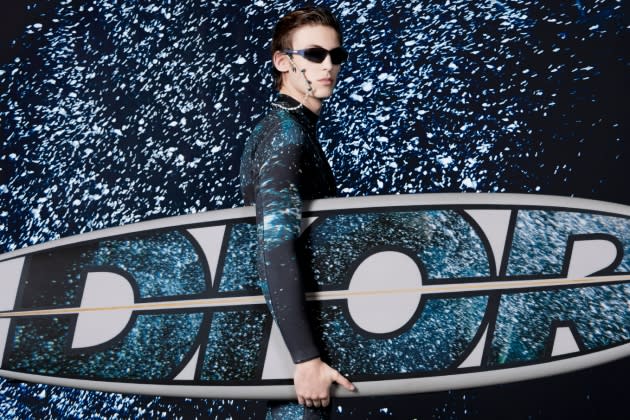Kim Jones and Cyrill Gutsch Talk Dior x Parley for the Oceans Collaboration

PARIS — Dior men’s designer Kim Jones and Parley for the Oceans founder and chief executive officer Cyrill Gutsch decided to forgo a splashy presentation for their second beachwear collaboration.
Instead, the duo sat down for a deep conversation in the private confines of Dior’s Avenue Montaigne store. They talked about their collaboration and the challenges of creating more sustainable collections in a fashion industry that is forever pumping out new product.
More from WWD
Fabrics in the surf-themed collection are made with recycled ocean plastics and abandoned fishing gear and took years to develop to Dior standards, Jones said.
Dior specified that 59 percent of the items in the collection used ocean plastic in their composition, and 37 percent used fabrics with a certification such as GOTS, which limits the use of toxic bleaches, dyes and other chemical inputs during the production process of textiles.
The French fashion house and Parley began their collaboration four years ago, and noted that it has only produced two collections so far.
Jones said that this shows just how challenging it can be to make real change in an organization.
“It’s been years of conversation before it could happen and get it to the level of where we could say these fabrics are suitable for Dior,” Jones said. “We have things like quality control, color testing and strength testing. All the work it takes — it’s not a short-term process. It takes time to turn around and we are moving as fast as we can.”
Having the house of Dior and the LVMH Moët Hennessy Louis Vuitton juggernaut behind him has helped as they develop the fabrics because they can invest in research and development.
“Irrespective of how products are made, we are very lucky to be in a company that has the perspective of the long term,” said Jones. The fabric quality is steadily improving, he said, and he is now incorporating the material into the “20 or so” other lines they make throughout the year, plus the team now has the instinct and impetus to experiment with other more sustainable, recycled and technologically advanced fabrics.
“We are taking from this and working it into different collections and programming it in, so it becomes something that as much as we can do with it, we will do it,” Jones said.
Gutsch emphasized that this is sending out ripples through other LVMH brands and the fashion industry at large.
“You know how difficult it is to change an organization if you don’t have a champion, and Kim decided to be a champion for change at Dior, which more or less makes it mandatory for lots of other companies to do the same,” he said. “It’s not just about the capsule, it’s really about inviting everybody in and also confronting themselves. I believe at this point in time it is about collaboration — and competition. Other brands understand that they have to move because their competitors are moving.”
Design still stands at the forefront of all the products, Jones added, which makes the success of the collection that much more rewarding. It even retails slightly above the average Dior price point. “That for me is the important thing, that you are doing something for the environment and people are buying it,” he said.
He also believes Christian Dior himself would want the company to push forward in its environmental standards. “We are speaking about savoir faire. You have to look at the founder and think, ‘What would he do now?’ One thing we know about Christian Dior is that he really loved nature and used it to create design. Hence, Parley seemed like a good idea for us to work with because it’s taking the essence of what the house is founded on.”
The young design team is very passionate about creating change within the industry and improving for the next generation, he added.
Jones, who said he wanted to be a zoologist when he was a teenager and still delights in learning about animals, spoke about being inspired when he went diving with whales off of Tahiti, as well as being saddened by the heaps of plastic on the beaches in Indonesia. The personal passion for the environment led him to working with Parley for the Oceans.
The two also discussed the idea of luxury, which they hope is changing with the next generation.
“We are really making things that can last for a long time. We know that we make small quantities, we know there is a resale market and we know they are things that go around, and we are looking to make things that last,” Jones said. “That is luxury for me.”
Gutsch added that while we are “living on a planet that is about to break,” he still believes we have the power to change.
“Every technology and material has its time, and we have to acknowledge that a lot of business practices are past their time…Making change and asking for change is scary. People don’t want change, so we have to make it attractive and desirable. We have to seduce, and I think design and art can move us on the journey,” he continued.
“This partnership allows us to see that things we thought that could not be united, can work together. Big corporations that have been polluters and destroyers can turn around,” he said. “Purpose and protecting the Earth can be luxury.”
Best of WWD

